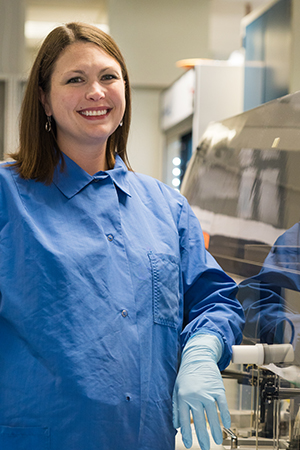
“We do a high volume of peanut component testing and are one of the few laboratories to offer this,” says Medical Director Patricia Slev. “There is a high demand because peanuts are one of the most common allergies tested for and one of the most severe types of allergies, so it’s important to know if you have it.”.
A peanut is the sum of its parts. And sometimes it is important to know which parts of the peanut may be triggering an allergic reaction. This is how a physician can differentiate between a true peanut allergy and cross-reactions with other common allergens found in a variety of foods.
“Determining which peanut components a person is allergic to can also predict the severity of the allergy. Some components are associated with high risk of severe, life-threatening reactions, while others may result in only mild reactions. This information can help guide a doctor in trying different therapies, as well as inform everyone involved the extent of caution needed,” explains Patricia Slev, PhD, a medical director at ARUP. For example, if the test indicates high likelihood of a severe reaction, then you may want to strictly avoid any traces of peanut including any products processed in a plant where peanuts are present.
If there is a family history of severe peanut allergies, the doctor may opt for a blood test prior to exposure to the food to avoid a life-threatening reaction.
Patricia Slev, PhD“Determining which peanut components a person is allergic to can also predict the severity of the allergy. Some components are associated with high risk of severe, life threatening reactions, while others may result in only mild reactions. This information can help guide a doctor in trying different therapies as well as inform everyone involved the extent of caution needed.”
Medical Director of Immunology Core Laboratory
University of Utah pediatric allergist Rafael Firszt, MD, often opts for both a skin and blood test when caring for patients who may be allergic to milk, eggs, peanuts, nuts, soy, or wheat. “Often, it is not enough to do just one or the other,” says Firszt, who emphasizes a patient’s clinical history is crucial in determining whether to follow up with testing. “Blood tests are not always accurate but they are very valuable as an adjunctive piece of the puzzle.” He points out scenarios in which a blood test is a better option than skin tests, including if the patient has taken an antihistamine within the last five days, cannot sit still long enough (15 minutes), or has a severe back rash. Two of the drawbacks regarding blood tests are that they generally cost more and the results are not immediate like with allergy skin testing.
Nuts Are Not Alone—Other Nutty but Rare Allergies

Jennifer Blackley, laboratory technical supervisor, says: “It’s not just the most common allergens we’re testing for but we’re able to detect the more rare allergens as well.” She rattles off some unusual ones including pigeon droppings, parakeet feathers, and gelatin (porcine and bovine).
Often when testing for peanut allergies, other nut allergies will also be tested for using a nut panel test, which homes in on eight different nuts: peanuts, walnuts, chestnuts, brazil nuts, hazelnuts, almonds, pecans, and cashews. Although peanuts are a legume and not related to tree nuts (i.e., almonds, walnuts, cashews, etc.), allergy to tree nuts is common in peanut-allergic individuals. About 35 percent of peanut-allergic toddlers in the United States have or will develop a tree nut allergy. It is fairly common to be “co-allergic” to tree nuts if a child is peanut allergic.
Peanut allergies are on the rise. According to one study , between 1997 and 2008 the incidence of peanut and tree nut allergies nearly tripled. Slev adds that food allergies in general have been on the rise, referring to a Centers for Disease Control and Prevention study, which also showed a link between increased allergic reactions and increased income levels.
Sophisticated instrumentation allows ARUP to provide a high volume of allergy test results, allowing them to produce more than 900 test results in an hour and detect more than 300 individual allergens to help diagnose both common and rare allergies. “We’ve had requests to test up to 60 allergens on people before,” says Jennifer Blackley, an ARUP technical supervisor.
A food allergy occurs when the immune system overreacts to a food. The most common type occurs when the immune system makes a type of antibody called IgE to proteins in a particular food. Eight foods account for 90 percent of all food-allergic reactions: milk, eggs, peanuts, tree nuts, wheat, soy, fish, and shellfish.
Cross-reactivity occurs when the protein in one food is also found in other foods. For example, reaction with one of the components of the peanut component panel predicts allergy to peach and peach-related fruits, because that protein is found not only in peanuts but in other plants as well.
“It’s not just the most common allergens we’re testing for but we’re able to detect the more rare allergens as well,” adds Blackley. She rattles off some of the more odd allergens, including pigeon droppings, rat and mouse urine, parakeet feathers, gelatin (porcine and bovine). Jell-O lovers beware.
By offering panel tests that can test for a grouping of allergens, clinicians are able to narrow down the possibilities more quickly. For example, the nut panel test might home in a specific nut, and then further home in on the allergic-causing components of that nut.
“We do a high volume of peanut component testing and are one of the few laboratories to offer this,” says Slev, who oversees the Immunology Core Laboratory and the Serological Hepatitis and Retrovirus Laboratory. “There is a high demand because peanuts are one of the most common allergies tested for and one of the most severe types of allergies, so it’s important to know if you have it.”
By Peta Owens-Liston, ARUP Science Communications Writer
















